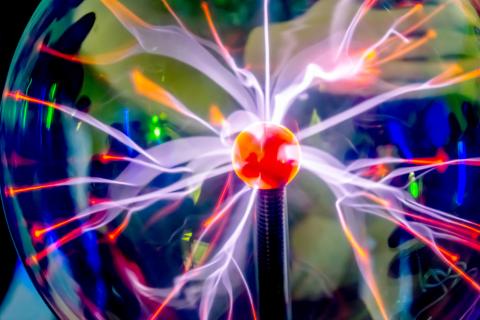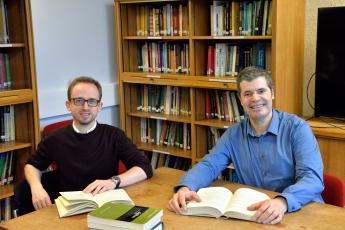
Into the World of Physics of the Infinite
Interview with Thierry Dufour and Christophe Balland.

Thierry Dufour, Thierry Dufour, senior lecturer at the Plasma Physics Laboratory1, and Christophe Balland, professor at the Nuclear Physics and High Energy Laboratory2, lead the IPI. Their objective: to bring together the driving forces of the Alliance Sorbonne University in an ambitious program combining plasma physics and the physics of the Universe and high energies.
How was the IPI formed?
Christophe Balland: In January 2020, this initiative inherited two LabEx (Laboratories of Excellence award): Plas@Par and the Institut Lagrange de Paris. The IPI thus covers a vast spectrum of topics ranging from the physics of the Universe and of high energy, to plasmas3, cosmology, particle physics and fusion. It brings together a dozen internationally recognized laboratories and renowned researchers with complementary expertise (observations, modelling, simulation, engineering, experimentation).
It also benefits from an exceptional heritage of research infrastructures (terrestrial and space astronomical observatories, particle gas pedals, high-intensity or electron lasers and ion beams). This human and technological capital is both unique in the world and an opportunity for teaching and research activities in physics of the infinite.
What is its objective?
Thierry Dufour: The aim of this initiative is to continue the activities initiated by the two historic LabExes and to bring together players in the physics of the Universe, high energies and plasma physics through the development of joint research and education projects. From the undergraduate to post-doctoral level, students are at the center of the projects carried out by the Initiative. The IPI also has the mission of conducting scientific communication activities for the general public, while working for diversity and equality between women and men.
Who do you work with on a daily basis?
C. B.: Led by two directors and a steering committee, the Initiative works in close consultation with the doctoral schools and masters programs that fall within its scope and the management of the core laboratories. In addition, the Initiative consults with the physics department at the Faculty of Science and Engineering, the presidency of Sorbonne University and the board of the Sorbonne University Alliance. While we encourage teams to come together from different laboratories, we also develop multidisciplinary interactions with other institutes and initiatives of the Alliance.
We also collaborate with external laboratories to extend the Initiative beyond the University and we call upon external thematic experts to evaluate the doctoral and post-doctoral projects we fund.
What research challenges does the IPI address?
C. B.: Research at the IPI is driven by core projects (specific to the physics of the Universe and high-energy or plasma physics) and projects at the interface of these two themes. One of our objectives is also to support exploratory projects of interdisciplinary openness where the physics of the infinite is combined with transversal approaches related to the humanities and social sciences. We hope, for example, to work with the Ancient Sciences Initiative on the history of science and astronomy.
To finance all these projects, the Initiative benefits each year from three doctoral candidates with three-year contracts and three post-doctorates with two-year contracts. Part of the budget of the Initiative is also devoted to the organization of scientific events to facilitate exchanges with members of the community.
And in terms of education?
T. D.: We are committed to promoting education through research. This is why we financially support summer schools from the third-year of the bachelor’s to the PhD level, in particular by encouraging the creation of courses capable of interfacing high-energy physics with plasma physics.
We will offer master's students visits to major infrastructures, such as the European laboratory for particle physics, so that they can familiarize themselves with these platforms and meet the teams working there.
What actions do you plan to carry out at the international level?
T. D.: One of the successes of Plas@Par and the Institut Lagrange de Paris has been their ability to attract excellent foreign students. We want to continue in this direction, for example by opening new double masters programs with the University of Pisa and the UC Berkeley.
This year we are launching a scholarship program to enable deserving students to complete their internships abroad, particularly in the partner laboratories of 4EU+ Alliance and other strategic partners of the Sorbonne University Alliance. This program will also be an opportunity for their supervisors to spend a few days with the host research team in order to strengthen the development of international collaboration.
What impact can the IPI’s work have on society?
C. B.: Plasma physics enables application development in many fields, such as medicine, space propulsion, the environment, materials and agriculture. For example, plasma can be used to boost plant growth or increase the germination capacity of plants.
While high-energy physics and physics of the Universe have a less direct societal impact, the questions they raise are of great interest to the general public. This is why we would like to organize conferences and exhibitions everywhere that scientific popularization is available, such as the Palais de la Découverte or the Cité des Sciences et de l'Industrie.
1 LPP: Sorbonne University/CNRS/Polytechnic School
2 LPNHE: Sorbonne University/CNRS-IN2P3/University of Paris.
3 Plasma is one of the four main states of matter, along with the solid, liquid and gaseous states. Matter becomes a plasma when it is heated at very high temperature or subjected to an intense electromagnetic field. The solar corona, for example, is a plasma.
